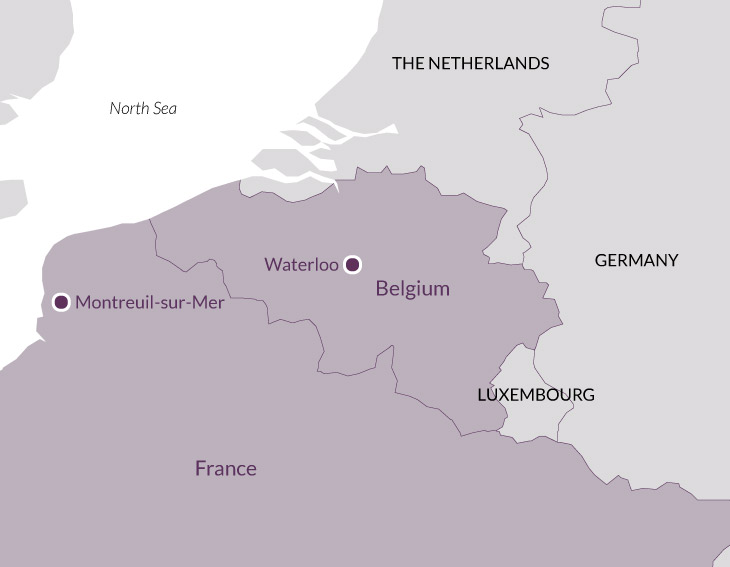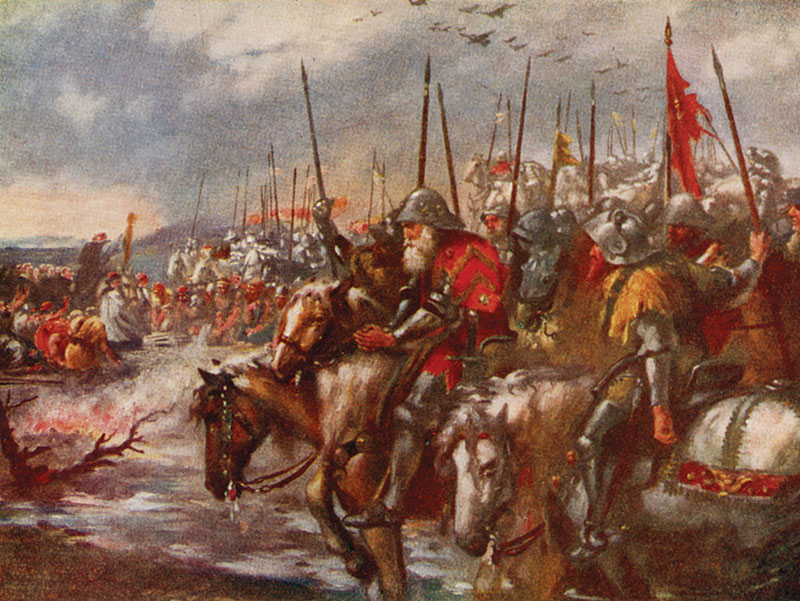Overview
The Battle of Waterloo in 1815 terminated twenty-three years of fighting and ushered in ninety-nine years of relative peace and political equilibrium. Waterloo can also be seen as marking Great Britain’s coming of age as a superpower. The event became absolutely key for British self-identity, epitomising the championship of liberty over tyranny, victory of the weaker over the stronger, and the value of the virtues of courage, composure, discipline and perseverance.
Despite its far-reaching consequences, Waterloo was far from being the biggest battle of the Napoleonic Wars, or the bloodiest, or even, in terms of imbalance of casualties, the most decisive. It was not even a particularly British victory – two-thirds of the allied army was German, Dutch and Belgian, and that is without including the Prussians, whose intervention late in the day ensured victory. Much of the enduring fascination of the battle – probably the most written-about in history – derives from these controversies and because it was ‘the nearest run thing you ever saw in your life’.
Wellington’s ‘infamous army’, though of similar size to Napoleon’s, contained a high proportion of inexperienced troops and citizen militia, and some who only a year previously had been marching under the imperial eagle. But they stood their ground tenaciously and finished the day in triumph. This was Wellington’s ultimate test, his chance to measure his abilities against Napoleon, whom he had never met in battle before. His generalship proved to be the superior.
Amazingly, fortuitously, all three battlefields are very well preserved. Crécy (1346) and Agincourt (1415) were also scenes of British victories over superior French forces and are major ingredients in the fading national myth. But it is not jingoism which brings these three battles together in this tour, but the contingency of geographical proximity – that and their fame. As a trio of events in British (pre-Victorian) history, their combined resonance is unsurpassed. A proper study of the battlefields leaves little room for partiality; ‘Nothing except a battle lost can be half so melancholy as a battle won.’
Day 1
Crécy. Take the Eurostar at 10.15am from St Pancras to Lille. Drive south through rolling countryside to the village of Crécy-en-Ponthieu. It was here in August 1346 that an English army commanded by Edward III and the Black Prince inflicted a crushing defeat on a numerically superior French and international force, victory of the longbow over knights in armour. The battlefield has changed little in topography and planting in 650 years. Overnight Montreuil.
Day 2
Agincourt. Similarly remote and rural, the little-altered terrain helps explain how Henry V and his exhausted followers brought catastrophe to the much larger French army. However, the traditional national myth and Shakespearean spin veils a more complex and controversial reality. After a brief visit to the visitors’ centre, have lunch in the vicinity before driving across Flemish France and Walloon Belgium to Waterloo. First of three nights in Waterloo.
Day 3
Quatre Bras, Ligny. The Wellington Museum is in the inn where the Duke spent the nights before and after the battle. During the day of 16th June some of the scattered allied contingents converged at Quatre Bras, but numerical inferiority led to a well fought defensive engagement and, on the 17th June, an orderly withdrawal admirably screened by cavalry. At the same time a much bigger battle was taking place 7 miles to the East at Ligny where the Prussians were badly defeated by Napoleon; this proved to be his last victory. Overnight Waterloo.
Day 4
Waterloo. All day is spent walking the battlefield, with stops for talks at key positions. Among the highlights are the farmstead of Hougoumont, held by the Guards throughout the day during the fiercest fighting, and the sweep of terrain across which the British cavalry drove back the advance of the French but exhausted themselves in the process. Also visit the panoramic painting of the battle (1912) and climb the Lion Mound. Finish the day by walking the course taken by Napoleon’s Guards towards the allied lines before they turned and fled in the face of deadly fire and bayonet charges. Overnight Waterloo.
Day 5
Plancenoit, Waterloo. Prussian troops entered the village of Plancenoit south of the battlefield and soaked up Napoleon’s reserves; the fighting was so fierce that little of the village survives. Visit the Napoleon museum in the house where he spent the night before the fateful battle. Return to London by Eurostar from Brussels arriving St Pancras c. 6.00pm.
Price – per person
Two sharing: £1,790 or £1,600 without Eurostar. Single occupancy: £2,020 or £1,830 without Eurostar.
Included
Return rail travel (first class, standard premier) on Eurostar London St Pancras to Lille, Brussels to London; travel by private coach within France and Belgium; hotel accommodation as described below; breakfasts, 1 lunch and all 4 dinners with wine, plus light meals on Eurostar; all admissions; all tips; all taxes; the services of the lecturer and tour manager.
Accommodation
Hotel Hermitage, Montreuil-sur-Mer: a 19th-cent. building in the centre of Montreuil converted into a 3-star hotel. Superior bedrooms are of a good size, the décor is modern. Martin’s Grand Hotel, Waterloo: located close to the battlefield, this 4-star hotel is in a converted 19th C. sugar refinery. Single rooms throughout are doubles for sole use.
How strenuous?
There is a lot of standing on exposed sites for extended periods of time. There is quite a lot of walking, the Waterloo day having about five miles on foot along country lanes, footpaths and fields. There is a long drive from Agincourt to Waterloo. Average distance by coach per day: 115 miles.
Are you fit enough to join the tour?
Group size
Between 10 and 22 participants.
Travel advice
Before booking, please refer to the FCDO website to ensure you are happy with the travel advice for the destination(s) you are visiting.

Gordon Corrigan’s site presentations of the conflicts were informative, descriptive, lively and involving, prompting interesting discussions with the guests.
In the future we would sign on for the lecturer: Gordon Corrigan is excellent. He knows his subject so well that he is not stuck to a script but able to digress and answer questions as only someone who knows far more than he is able to tell you in the time available can do.
